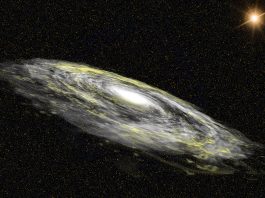A collaborative research team including the University of Cologne and Masaryk University in Brno have observed the S4716 Star, the fastest known star in the Milky Way.
Researchers at the University of Cologne and Masaryk University in Brno (Czech Republic) have discovered the fastest known star, which travels around a black hole in record time. Scientists have observed that the star, S4716, orbits Sagittarius A* – the black hole in the centre of the Milky Way – in a four-year time frame and reaches a speed of approximately 8,000 kilometres per second. S4716 comes as close as 100 astronomical units (AU) to the black hole, which is considered a small distance by astronomical standards; one AU corresponds to 149,597,870 kilometres.
This study was recently published in The Astrophysical Journal.
The S cluster: Home to over 100 fast-moving stars
Scientists have observed that the vicinity of the black hole at the centre of our galaxy holds a densely packed cluster of stars. This cluster is called the S cluster and is home to well over 100 fast-moving stars that differ in their brightness and mass.
“One prominent member, S2, blocks your view of what is important,” explained Dr Florian Peissker, lead author of the study. “The view into the centre of our galaxy is therefore often obscured by S2. However, in brief moments we can observe the surroundings of the central black hole.”
What was involved in identifying the S4716 Star?
The research team continuously refined methods of analysis in tandem with observations spanning approximately 20 years. This led to the scientists being able to accurately identify a star that travels around the central supermassive black hole in just four years. In total, five telescopes were utilised to observe the star. Four of the five telescopes were combined into one large telescope to allow scientists to document even more accurate and detailed observations.
“For a star to be in a stable orbit so close and fast in the vicinity of a supermassive black hole was completely unexpected and marks the limit that can be observed with traditional telescopes,” noted Peissker.
Moreover, it has been noted that this discovery sheds light on both the origin and evolution of the orbit of fast-moving stars in the heart of the Milky Way. “The short-period, compact orbit of S4716 is quite puzzling,” concluded Michael Zajaček, an Astrophysicist at Masaryk University, Brno. “Stars cannot form so easily near the black hole. S4716 had to move inwards, for example by approaching other stars and objects in the S cluster, which caused its orbit to shrink significantly.”









